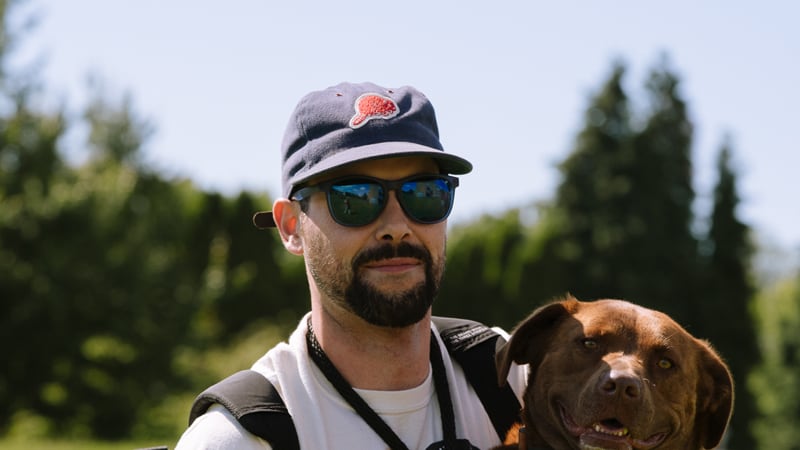For over a decade, people living in the Hosford-Abernethy neighborhood of Southeast Portland had a handshake agreement with a series of principals at Hosford Middle School.
Dog owners could use the school’s vast field as an off-leash dog park after school hours so long as neighbors picked up their pooches’ poop and ensured that no holes dug by dogs were left for children to trip on.
When the pandemic hit, that unofficial dog park became a social lifeline.
Basil Costandi had just adopted Cassius, a terrier-Lab-boxer mix. He went to the field each day to run Cassius and says he met upward of 50 of his neighbors there.
Then, this spring, the school enclosed the entire field with a chain-link fence. Soon, Hosford locked its five gates night and day.
What ensued blocks from Southeast Division Street is a heated dispute—an anti-government rebellion, even—over access to greenspace in a growing city.
The fight manages to embrace many of Portland’s most tender grievances: social isolation during COVID, people with mental illness and addiction creating friction in public spaces, and rapid development that makes everyone feel jammed together without a relaxing way to socially interact. (City officials say 345 apartment units have opened in the Hosford-Abernathy neighborhood and in blocks directly east of the school since 2017, making it among Portland’s fastest-growing areas.)
But most of all, the conflict demonstrates just how deeply attached Portlanders are to their dog parks—even ones that don’t officially exist.
Portland Public Schools says it has no legal obligation to leave the field open to neighbors.
Portland Parks & Recreation tells WW the bureau “does not have any agreement with [Hosford] that would prevent the school from installing fencing or placing conditions on access.”
The school district argues its land is meant for kids, and that it’s entitled to restrict use whenever it deems appropriate for safety reasons.
Neighbors retort that their taxpayer dollars helped pay for the field, and that taking away such a valuable greenspace is a death knell for their community.
“For so many people, that was their only sense of community during COVID,” Costandi says. “I was there every day. It’s really sad, it’s really depressing. It’s almost like the school takes pride in shitting on us.”
After the school district locked the gates this spring, neighbors organized.
Julian Bermudez spearheaded that movement. He collected video testimony of neighbors locked out of the field and others who said they’d been yelled at or intimidated by two school custodians tasked with keeping people off the field; video of a youth soccer team climbing over the fence to practice; and video of a mother boosting her baby over the fence.
One neighbor described on camera how a school custodian came to her home to question her about cut locks.
“He knocked on my door, he had a PPS badge. He asked if I knew anything about the locks being damaged and then asked if I would be a scout for him and gave me his phone number,” she said. “It was intimidating.”
Another woman said a janitor locked the gate while she was inside and refused to let her out.
A man warned in a video that such security is how so many people died during the 1912 Triangle Shirtwaist Factory fire in New York City. (He fudged the details a bit; workers were locked in the upper floors of a burning, 10-story building, not a large grassy field.)
The district says it’s received no complaints alleging such behaviors, but custodians have reported being harassed by neighbors.
The locks have been cut at least a dozen times, according to neighbors who spoke with WW. (One neighbor posted a photo on Twitter in April of a locked gate: “Nothing a bolt cutter can’t liberate.”)
Portions of the fence have been cut so people can squeeze through. One gate is now completely disconnected from the fence on both sides, and only three locks keep it from falling over.
A sign posted in the neighborhood reads in part: “Are you concerned about the safety of children being locked inside the yard and unable to escape in the event of an emergency like the Texas tragedy?”
The district tells WW it locked the fences because of after-hour parties where drug and alcohol paraphernalia were left behind, “a child bitten by an off-leash dog, a child breaking a limb after tripping in a divot made by dogs…[and] students returning from recess covered in dog feces.”
Multnomah County spokeswoman Julie Sullivan-Springhetti says between 2017 and June 2021, eight dog-related incidents at Hosford were reported to the county, “including two loose, aggressive dog calls, three other loose dog calls, two bite incidents, and one stray dog.”
Parks bureau spokesman Mark Ross tells WW it does not plan to add off-leash dog areas to the parks system because of resource constraints.
David Menschel, a dog owner nearby, says “99% of what goes on there is benign, if not actively good.”
For years, the relationship between the school and dog owners has been uneasy.
As far back as 2009, the school district threatened to crack down on unleashed dogs. In 2014, a few neighbors tried to broker a truce, starting a bank account where neighbors could chip in maintenance fees. Versions of this had been tried before, but this particular system worked fairly smoothly. The neighbor who championed the initiative, Ashley Henry, removed herself in 2019.
In early 2020, Portland Public Schools informed dog owners at a meeting held at Hosford that their pets would have to be leashed while on school grounds or fines would be enforced. The meeting was hostile, and the district brought one of its attorneys.
When the school district decided to lock all the gates to the field this spring, the battle found new life.
In an April 2022 newsletter to Hosford parents, interim principal Joe Mitacek wrote that “custodians who try to enforce [the leash rule] have been subject to harassment by dog owners.”
Another concern for the district: mentally ill and homeless people wandering onto the field.
In March 2019, a naked man with a hatchet and knife ran onto the field. The school went into lockdown, and he stabbed a police officer during his arrest.
In an email to staff for state Rep. Rob Nosse, whose district includes Hosford, Mitacek was candid: “The fencing project is one that was requested some time ago due to homeless people coming onto the campus.”
WW visited the field two times in the past week. Dog owners tossed balls across the grass, chatting with one another amicably. Gates had been cut on both occasions.
On the first visit, Bermudez walked by one of the school’s custodians. “Hey!” he called to the janitor, addressing him by his first name. The custodian lowered his head, shook it and kept walking, not acknowledging Bermudez.
Bermudez says he and his neighbors are willing to help maintain the field, and all they want is to meet with the district and discuss finding a middle ground: “Those are things that we’re willing to negotiate,” Bermudez says—but he says the district has been unresponsive to their pleas.
“Collaboration is a really basic thing to ask for,” Bermudez says.
District sources tell WW entitlement to a space meant to serve Portland children is selfish and tone deaf.
Meanwhile, PPS is strapped for cash. Next year, it plans to cut 88 teaching positions due to budget shortfalls. District sources tell WW the last thing they have is money to maintain a campus trampled by off-leash dogs.
On Tuesday morning, a construction worker replaced two of the most commonly used gates with permanent fencing. A handwritten sign on one of the gates, reading “Communities die without green space,” had been taken down. By Tuesday evening, the fence where the gate had once been was completely carved out, leaving plenty of room for dogs and owners to enter the field.
Angela Uherbelau, an education advocate and public school parent whose Irvington community is also negotiating with the local elementary school to provide field maintenance, says she empathizes with the need for greenspace but thinks the neighbors should take a less destructive resistance tactic than cutting locks.
“The time and labor that’s spent continuing to replace locks could be going to other things that our kids desperately need,” Uherbelau says. “The district might seem like a faceless behemoth, but the impact is really on kids.”
This article was published with support from the Jackson Foundation, whose mission is: “To promote the welfare of the public of the City of Portland or the State of Oregon, or both.”

